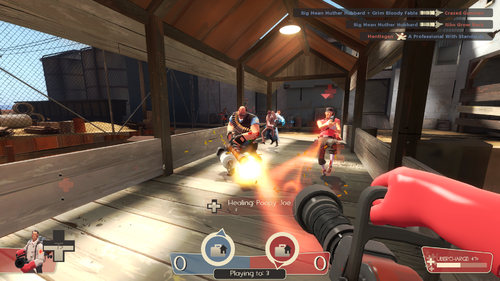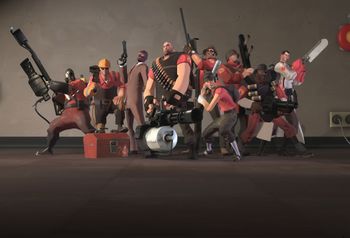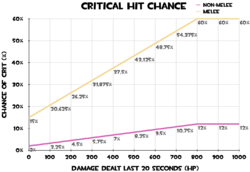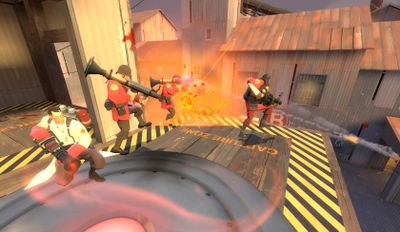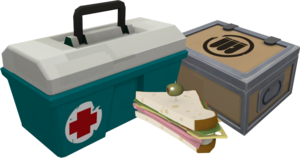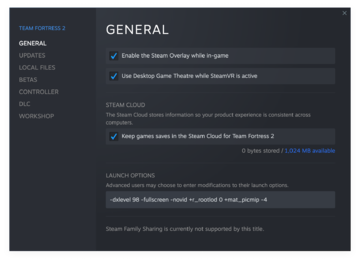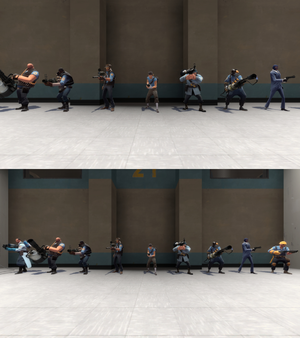Mechanics
| “ | And that is how you do it, men!
Click to listen
— The Soldier demonstrating success
|
” |
The mechanics of Team Fortress 2 define the rules and capabilities for players, servers, and content editors. Understanding these mechanics allows for more streamlined and comprehensive gameplay.
Engine
Team Fortress 2 runs on the Orange Box version of the Source Engine, which supports Microsoft Windows, Xbox 360, PlayStation 3, Mac OS X, and Linux. This version of the engine introduces hardware face rendering, soft particles, and multicore rendering. The game is intended to be played with up to 24 players (18 on Xbox 360 and 16 on PlayStation 3), although servers on Windows and Linux can support up to 32 players. While servers can technically allow up to 100 players, this is not supported and not recommended by Valve.
All player actions and settings are controlled through console commands and console variables (ConVars). Team Fortress 2 originally ran as a 32-bit application but introduced a 64-bit version in the April 18, 2024 Patch update, which became the default option and improved performance.
Classes
There are nine playable classes in Team Fortress 2, which are categorized into three areas- "Offense," "Defense," and "Support," though these categorizations mostly have no impact on gameplay. The abilities and stats of the classes can vary based on their loadouts.
 Scout: An offensive class with 133% move speed and 125 health points, specializing in hit-and-run combat and objective-capturing. Can double jump and capture control points (and push Payload carts) at double the rate of any other class. The Scout is armed with the Scattergun, a Pistol, and a Bat by default.
Scout: An offensive class with 133% move speed and 125 health points, specializing in hit-and-run combat and objective-capturing. Can double jump and capture control points (and push Payload carts) at double the rate of any other class. The Scout is armed with the Scattergun, a Pistol, and a Bat by default.
 Soldier: An offensive class with 80% move speed and 200 health points, able to adapt to a variety of situations, making him great for both attack and defense. Can rocket jump to reach normally unreachable places. The Soldier is armed with the Rocket Launcher, a Shotgun, and a Shovel by default.
Soldier: An offensive class with 80% move speed and 200 health points, able to adapt to a variety of situations, making him great for both attack and defense. Can rocket jump to reach normally unreachable places. The Soldier is armed with the Rocket Launcher, a Shotgun, and a Shovel by default.
 Pyro: An offensive class with 100% move speed and 175 health points, ideal for close-quarters combat and group support. Can ignite enemies, use compression blast to reflect projectiles and extinguish teammates, and is not affected by afterburn from fire-based attacks. The Pyro is armed with the Flame Thrower, a Shotgun, and a Fire Axe by default.
Pyro: An offensive class with 100% move speed and 175 health points, ideal for close-quarters combat and group support. Can ignite enemies, use compression blast to reflect projectiles and extinguish teammates, and is not affected by afterburn from fire-based attacks. The Pyro is armed with the Flame Thrower, a Shotgun, and a Fire Axe by default.
 Demoman: A defensive class with 93% move speed and 175 health points, specializing in area denial and damage output. Can sticky jump. The Demoman is armed with the Grenade Launcher, a Stickybomb Launcher, and a Bottle by default.
Demoman: A defensive class with 93% move speed and 175 health points, specializing in area denial and damage output. Can sticky jump. The Demoman is armed with the Grenade Launcher, a Stickybomb Launcher, and a Bottle by default.
 Heavy: A defensive class with 77% move speed and 300 health points, excelling in dealing and receiving sustained damage. The Heavy is armed with the Minigun, a Shotgun, and his own Fists by default.
Heavy: A defensive class with 77% move speed and 300 health points, excelling in dealing and receiving sustained damage. The Heavy is armed with the Minigun, a Shotgun, and his own Fists by default.
 Engineer: A defensive class with 100% move speed and 125 health points that specializes in area denial and support. Can create, maintain, upgrade, move, and control buildings. The Engineer is armed with a Shotgun, a Pistol, a Wrench, and two PDAs by default.
Engineer: A defensive class with 100% move speed and 125 health points that specializes in area denial and support. Can create, maintain, upgrade, move, and control buildings. The Engineer is armed with a Shotgun, a Pistol, a Wrench, and two PDAs by default.
 Medic: A support class with 107% move speed and 150 health points that focuses on improving the longevity and efficiency of teammates. Can regenerate health passively and is capable of healing teammates and deploying ÜberCharges on both teammates and himself. The Medic is armed with the Syringe Gun, a Medi Gun, and a Bonesaw by default.
Medic: A support class with 107% move speed and 150 health points that focuses on improving the longevity and efficiency of teammates. Can regenerate health passively and is capable of healing teammates and deploying ÜberCharges on both teammates and himself. The Medic is armed with the Syringe Gun, a Medi Gun, and a Bonesaw by default.
 Sniper: A support class with 100% move speed and 125 health points, ideal for long-distance target elimination. Can headshot with his primary weapon. The Sniper is armed with the Sniper Rifle, a Submachine Gun, and a Kukri by default.
Sniper: A support class with 100% move speed and 125 health points, ideal for long-distance target elimination. Can headshot with his primary weapon. The Sniper is armed with the Sniper Rifle, a Submachine Gun, and a Kukri by default.
 Spy: A support class with 107% move speed and 125 health points, ideal for covert disruption and assassination. Can disguise, sap buildings, cloak, headshot (With the Ambassador only) and backstab. The Spy is armed with the Revolver, a Sapper, a Butterfly Knife, a Disguise Kit, and an Invisibility Watch by default.
Spy: A support class with 107% move speed and 125 health points, ideal for covert disruption and assassination. Can disguise, sap buildings, cloak, headshot (With the Ambassador only) and backstab. The Spy is armed with the Revolver, a Sapper, a Butterfly Knife, a Disguise Kit, and an Invisibility Watch by default.
Combat
Combat is the primary means through which opposing teams compete for objectives. Team Fortress 2 has a variety of mechanics that influence combat, such as explosives, Sentry Guns, shotguns, and much more.
Damage
Most weapons deal damage to health points. Unless the server's rules are modified, weapons do not cause damage to teammates, though many weapons are capable of dealing self-damage to their user. Weapon damage is subject to a number of variables, though the vast majority of weapons don't deal locational damage (the main exceptions being Sniper or Spy headshots and Spy backstabs). Most weapons deal increased damage to targets that are nearby and reduced damage to targets that are far away, though Mini-Crits are not subject to the latter and Critical hits are subject to neither. Distance modifiers to damage are based on the distance between attacker and target on-hit (as opposed to the position of the attacker when the attack was first made). Explosive damage is reduced as the target's distance from the explosion's center increases. While most explosive weapons can hurt their users, the Soldier and Demoman are granted damage reduction to their own explosive attacks.
Unless disabled by a server setting, most weapons semi-randomly deal Critical hits. Critical hits are not subject to damage randomization or distance-based damage modifiers, and always deal 300% of the weapon's base damage. Critical attacks are usually accompanied by team-colored visual effects and electric shock sound effects (most noticeably on explosive projectiles). Usually, non-melee attacks have a 2-12% chance to become critical based on recent damage output while melee attacks have a 15-65% chance; however, some weapons, like the Market Gardener, are unable to get random Critical hits. When hit by a critical attack, text appears above the target's head, a distinct hit sound is played, and the target is subject to greatly increased knockback. Critical attacks do not deal extra damage or knockback to their users, though they may provide visual or audio cues that suggest they do. Critical hits do not stack onto a single attack.
A variety of weapons and status effects can cause Mini-Crits. Mini-Crits function similarly to Critical hits, though they only deal 135% base damage, provide less knockback than a full Critical hit, and do not produce the same audio-visual effects. Additionally, while Critical hits deal the same damage regardless of distance, Mini-Crits are subject to damage ramp-up when attacking from close range. If an attack would be both a Mini-Crit and a Critical hit, it will function as though it were only a Critical hit. Like critical attacks, Mini-Crit attacks do not cause increased damage to their users.
Buildings are not subject to extra damage from Critical hits and Mini-Crits, nor are attacks against them modified by distance. Likewise, attacks made by buildings themselves are not subject to distance-based damage modifiers and cannot become Critical hits, though they still may become Mini-Crits.
Hit detection
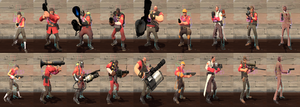
Most weapons are either projectile weapons or hitscan weapons.
- Projectile weapons, such as the Rocket Launcher, produce moving objects with positioning and effects determined by the server's game state, which makes them less reliable for players with high latency. Projectiles usually have unique rules of physics applied to them separately from the player, and player velocity is not used in determining the initial velocity of projectiles. Projectiles do not spawn from the center-screen, but from the side on which the weapon is held (a right-handed Soldier produces rockets from his right-hand side). Projectile collision detection does not use model-conforming hitboxes; instead, a projectile hit detection relies on a single, large hitbox, also used for collisions with the map and other players, that completely encompasses the player model, and does not vary based on the player’s class or animation, except for crouching (for example, a standing Heavy has the same projectile hit detection as a running Scout, but different from a crouched one). The Pyro's particle-based flame attacks follow most projectile weapon mechanics.
- Hitscan weapons, such as the Minigun, produce instant hit-or-miss attacks instead of projectiles. Melee weapons and bullet/pellet-producing weapons are generally hitscan. Collision detection with hitscan weapons favors the point of view of the attacker (using Lag compensation), which can produce somewhat disjointed results in the victim's point of view ("I already got behind cover; how did that hit me?"). Hitscan weapons are produced from center-screen, even if visual effects seem to suggest otherwise. Non-melee hitscan weapons use fairly accurate model-fitting hitboxes (a standing Heavy would indeed be a much larger target than a standing Scout); melee weapons use the same large hitbox used by projectile weapons.
- Non-melee hitscan weapons will fire a bullet or at least one pellet perfectly accurate down the crosshair if the weapon has not been fired for at least 1.25 seconds (notably, the Sniper Rifle's shots always occur after this period). After an accurate shot, the weapon will incur a period of slight inaccuracy unless the weapon is held from firing for 1.25 seconds. The two exceptions to this rule, the Ambassador and the Enforcer, are affected by a shorter period of inaccuracy, lasting only until the crosshair has shrunk to its normal size for the Ambassador and an equal amount of time for the Enforcer. This period is a little less than a second long (about 0.9s).
Weapon types
Each class has a unique set of weapons at their disposal occupying weapon slots 1, 2, and 3 (often referred to as primary, secondary, and melee, respectively). The Engineer's PDA also uses slots 4 and 5, and the Spy's Disguise Kit uses slot 4. The choices players make in choosing weapons and items constitute their loadout.
Most non-melee weapons require Ammo for use. Weapons that use Ammo can be either reserve-based (having a limited clip size and requiring reloading from stored ammo, such as the Pistol) or fully-loaded (capable of using all ammo without reloading, such as the Minigun). Reserve-based weapons either use magazine-style reloading (reload fills loaded ammo in single, one-time animation, such as the Revolver) or sequential reloading (reloads ammo from reserve one at a time, such as the Shotgun). Reloading can be interrupted at any time by attacking or changing weapons, though time spent reloading (beyond the last carried ammo increment, in the case of sequential weapons) is wasted. When reloading a sequential reload weapon, a different animation and reload time is used for reloading the first ammo and subsequent ammo (for example, an emptied Grenade Launcher takes 1.24 seconds to reload 1 ammo, plus 0.6 seconds for each ammo after that).
Many weapons that don't use ammo must be recharged instead (such as Jarate, and the Sandman). Recharging can usually be done by waiting for a set amount of time, going to the resupply cabinet, or respawning. Some weapons without ammo require manual refills based on specific requirements, such as the Medi Gun (which requires refill for ÜberCharge, though not for healing) and the Buff Banner.
Status effects
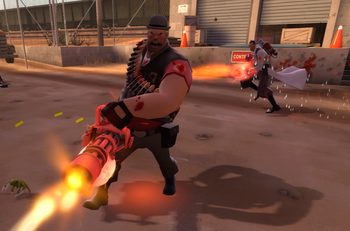
Status effects include a variety of weapon-induced player conditions, such as Fire and Bleeding. All status effects are removed by death, touching a Resupply Locker, or class change, and most negative effects are removed by ÜberCharge. Some can be removed by healing or submersion in water. There are both positive and negative effects.
Positive effects
- Invulnerable/ÜberCharged: An invulnerable player is completely immune to almost all forms of damage and negative status effects, although they are still capable of receiving knockback, whether it be from enemy attacks or an enemy Pyro's compression blast. However, they are not immune to environmental hazards (such as Sawblades, Trains, falling off a cliff/into a pit, etc.) or being Telefragged. Invulnerable players are not immune to being stunned by the initial strike of the Arm Blender, Arrow Stab, and Uberslice taunt attacks (though they will still inflict no damage). They are also susceptible to the Holiday Punch's laugh-inducing Critical hits. Invulnerable players can be identified by their bright team-colored shimmer and glowing eyes caused by the Medi Gun's ÜberCharge, escaping from most Underworlds, temporarily with an overheal spell, stunning Merasmus with a bomb, and more.
- Megaheal: A player under this effect is immune to movement-impairing effects (such as knockback, stun, and slowdown) and is healed at 100.8-302.4 HP per second (depending on how recently the player was damaged), or 3x the Quick-Fix's base heal rate. Megahealed players have a glowing ring around their feet, similar to the Buff Banner. Received by the Quick-Fix's ÜberCharge.
- Crit boost: All attacks from a player under the effects of a Crit boost will be Critical hits. The weapons of such a player glow with team-colored electricity. Received by the Kritzkrieg, Killing Gloves of Boxing, Frontier Justice, Diamondback, Chargin' Targe, Splendid Screen, and the Phlogistinator; also occurs after capturing the Intelligence and attaining First Blood on most servers, collecting a Halloween pumpkin on a Haunted Halloween Special, escaping from most Underworlds, or for the winning team during humiliation. The Cow Mangler 5000 cannot deal Critical hits at all, and will always deal Mini-Crits instead.
- Mini-Crit boost: All attacks from a player under the effects of a Mini-Crit boost will be Mini-Crits. Mini-Crit boosted weapons glow with electricity based on team color, with a slight yellow tint (greenish-blue for BLU, orange for RED). Received by the Crit-a-Cola, Buff Banner, Chargin' Targe, Splendid Screen, Tide Turner, Buffalo Steak Sandvich, and the Cleaner's Carbine. The Bushwacka and Fan o' War cannot deal Mini-Crits at all, and will always deal Crits instead.
- Overheal: An overhealed player's health is above 100% (limited to 150%, 125% with Quick-Fix). Overhealed players emanate health icon-shaped, team-colored particles. Received by the Medi Gun, Kritzkrieg, Vaccinator, Quick-Fix, Eyelander/Nessie's Nine Iron/Horseless Headless Horsemann's Headtaker, Conniver's Kunai, Dalokohs Bar/Fishcake, Half-Zatoichi and escaping from most Underworlds.
- Evasion/Phasing: Very functionally similar to being ÜberCharged, although players under this effect are incapable of attacking or switching weapons and are forced into a third-person perspective. Evasive players produce an afterimage distortion effect behind them, and attacks against them cause flashes of text indicating misses. The only item to cause this effect is the Bonk! Atomic Punch.
- Hype Mode: Hype mode allows the player (as the Scout) to perform 5 additional air jumps (6 in total) while the effect is active. A magenta glow is applied to the player's active weapon. The only item to cause this effect is the Soda Popper. The player has to inflict damage with any of the Scout's weapons to charge the meter.
- Speed Boosted: A 40% speed boost is applied, which caps at 150% of the basic move speed. Speed-boosted players are indicated by a wind breeze particle effect surrounding them. Received by Disciplinary Action, the buff from The Concheror, getting a kill with the Big Earner and the Axtinguisher/Postal Pummeler, feigning death with the Dead Ringer, hitting an enemy with the Eviction Notice and the Hot Hand, escaping from most Underworlds, and going through the door on the clock tower in Helltower.
- Damage Softening: Players benefiting from damage softening receive 50% less damage from Sentry Guns and 35% from all other sources, and reduce damage and knockback from Critical hits and Mini-Crit. Such players have a glowing ring around their feet (an effect shared by the Buff Banner's Crit boost effect). Received by the Battalion's Backup.
- Resistance: Players can have up to three resistance types deployed on them. Those resistance types are called Bullet Resistance, Blast Resistance, and Fire Resistance. These Resistance types can be deployed by Vaccinator, and the reduction value will rise from 10% to 75% with additional Crits protection when ÜberCharged.
- Heal Ring: A team-colored ring that heals players 25 health per second. Received by the Amputator.
Negative effects
- Fire: A burning player takes damage over time (an effect known as Afterburn), to which Pyros are immune (unless they are coated by the liquid from the Gas Passer). From most sources, this deals 4 damage every 0.5 seconds for a maximum of 10 seconds (depends on the weapon used). Afterburn damage is decreased for the Degreaser. Received by the Flame Thrower/Rainblower/Nostromo Napalmer, Backburner, Degreaser, Phlogistinator, Dragon's Fury, ignited arrows, Flare Gun, Detonator, Manmelter, Scorch Shot, Sharpened Volcano Fragment, Huo-Long Heater, the charged shot from the Cow Mangler 5000, touching the lava or fireballs on Hellfire and taking any damage while coated by the Gas Passer. Afterburn from flamethrowers decreases healing by 20%.
- Bleeding: Bleeding players take damage over time. Bleeding duration is based on the source (either 5 or 6 seconds), dealing 4 damage every half-second. Received by the Southern Hospitality, Tribalman's Shiv, Boston Basher/Three-Rune Blade, Flying Guillotine, the projectile (bauble) from the Wrap Assassin and arrows with the +5s Bleed On Target upgrade in Mann vs. Machine. Different sources of bleed (e.g. a hit from the Southern Hospitality and getting hit by the bauble from the Wrap Assassin at the same time) stack on top of each other, while the same source of bleed (e.g. 2 hits in a row from the Boston Basher by the same player) will only reset the duration. Getting hit by the same source from different players does stack.
- Slowdown: The enemy's movement speed is reduced. Received by getting hit with Natascha or the Sandman's ball, or after the effects of Bonk! Atomic Punch expire while damage was absorbed.
- Jarate: Attacks made against Jarate-soaked players become Mini-Crits. Jarate-soaked players are tinted yellow and drip yellow droplet particles, which partially reveal cloaked Spies. Received by Jarate/Self-Aware Beauty Mark, the Sydney Sleeper, and one of Merasmus' spells. When soaked by Jarate, players are considered "wet".
- Milk: Players who attack Milk-soaked enemies are healed for 60% of the damage dealt (does not overheal). Milk-soaked players drip white droplet particles, which partially reveal cloaked Spies. Received by Mad Milk/Mutated Milk, as well as any Medic Primary (excluding the Crusader's Crossbow) with the Mad Milk Syringes upgrade in Mann vs. Machine. When soaked by the Mad Milk, players are considered "wet".
- Fleeing State: Fleeing players move 10% slower, cannot move while crouched, and cannot fire or change weapons (although they can taunt). Such players can be recognized by their change in character animations, which vary by class (most can be characterized as looking "frightened" or "disappointed"). Received by humiliation, Ghosts, and the Horseless Headless Horsemann's "Boo".
- Marked For Death: All damage from attacks made against players who are Marked For Death become Mini-Crits. A player who is Marked For Death has a white skull and crossbones image above their head. Unlike Jarate, Marked For Death cannot be removed by being submerged in water, charging, being healed by a Medic or a Dispenser, or touching a Resupply Locker. The only cure is waiting it out. Scouts can mark enemies for death with the Fan O'War, Soldiers are Marked For Death while using the Escape Plan and for one second after switching weapons, Scouts are marked for death for 5 seconds after attacking while under the effects of the Crit-a-Cola, Engineers are Marked for Death when hauling a building with the Rescue Ranger equipped (whether picked up from a distance or not) and for one second afterward, and any class can be marked for death by being slimed by an egg sack explosion or hit by a Salmann on Slime. Additionally, in Mann vs. Machine, the Sandman can be upgraded to apply a Marked For Death upon any robot hit by the baseball or the melee swing. In Mannpower, holding the flag for 90 seconds marks the Intelligence courier for death.
- Gasoline: Players soaked in gasoline after passing through the cloud of the Gas Passer are ignited for 10 seconds when hit (this includes self-inflicted damage from the Rocket Jumper and the Sticky Jumper). This effect includes enemy Pyros. Players with this effect are covered in green droplets. When soaked by gasoline, players are considered "wet".
Knockback
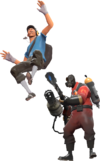
Most weapons produce at least some sort of knockback, much of which is too small to notice. Attack modifiers to knockback include damage, Critical hit or Mini-Crit status, and weapon-specific effects. Knockback can be used to manipulate the positioning and movement of players, especially those of enemies through juggling, and oneself through rocket jumping or sticky jumping. Some weapons and abilities, such as the Force-A-Nature, the Shortstop's alt-fire, and compression blast, are based on unique knockback functionality. ÜberCharged targets are less influenced by enemy knockback than normal targets, and Megahealed players and Disguised Spies are not subject to knockback from enemy weapons, but a compression blast will affect Disguised Spies.
Environment
Depending on the map and server, the goals and rules of the TF2 gameplay can change dramatically. By understanding these variables in gameplay (and how to parse them in the Server Browser), players can find a game environment that suits them and fully contribute to their team's goals.
Objectives
Maps are made based on a variety of game modes, which are used to determine the objectives for both teams. Teams may compete over the same goals (such as in Standard Control Point and King of the Hill maps) or oppose each other in an offense vs. defense setup (such as in Attack/Defend Control Point and standard Payload maps).
Many game modes use control points. Control points begin to be captured when a player of a team not owning the point stands on the point. The capture time varies by map, and its speed is increased when more players stand on it (though each player beyond the first provides diminishing returns). Capture is halted when an opposing team member stands on it in defense, and capture progress is gradually undone when no capturing teammates stand on the point. Control points cannot be captured while "locked", and locked points are usually unlocked after preceding points are captured. Payload carts are pushed and halted the same way control points are captured, though instead of capturing a Payload cart, the pushing team tries to bring it to a checkpoint. ÜberCharged players cannot capture points or push carts, though they can defend them.
In official maps with offense vs. defense game modes, BLU plays offense while RED plays defense. In such maps, BLU tends to have faster respawn times, but RED is given a setup time to prepare a robust defense.
- Arena: Players spawn only at the beginning of the round, with no respawning. After a set time, a neutral control point unlocks, which can be captured to win the round. If all members of a team die, that team loses the round. Has First Blood and automated team assignment/shuffling by default. Official arena maps don't have resupply Lockers.
- Capture the Flag (CTF): Teams work to capture the opposing side's Intelligence faster than their opponents do the same. Any player can pick up an enemy's Intelligence, and their team gains a point if that player returns the enemy's Intelligence to their team's own original Intelligence spot. The Intelligence drops on command or when its carrier dies; it is returned to its original location if it remains on the ground for a set time after being dropped.
- Control Point, Standard (CP): Each team starts with two locked control points and fight for the middle, neutral control point. From then on, at any given time, each team's furthest control point is unlocked, while all others are locked. Teams must capture all five control points to win the round.
- Control Point, Attack/Defend (CP): If the offensive team captures all of the defense's control points before time runs out, they win (if the defense can prevent this, they win). In most maps, only one control point is unlocked at a time (the notable exceptions being Steel, Frostwatch and Hadal).
- King of the Hill (KOTH): Each team has their own countdown timer, and a team wins when their countdown timer reaches zero. A team's timer counts down while they own the control point, but is frozen while that team does not have ownership of the control point. Note that a team's timer will still count down even if there are enemies trying to capture the point.
- Mann vs. Machine (MVM): A team composed of up to six human players must fend off waves of AI-controlled robots, stopping them from delivering a bomb to the map's stronghold. Players are able to collect cash from destroyed robots to buy upgrades during and between waves. Offense wins if the bomb is delivered successfully, while defense wins by successfully warding off all the waves.
- Payload (PL): Offense pushes the Payload cart in a manner similar to capturing a control point, trying to reach checkpoints instead of finishing point captures. The Payload cart supports allies as if it were a level 1 Dispenser. Offense wins if the cart reaches the final checkpoint, while defense wins by making sure the cart doesn't reach the final point before the timer counts down to 0.
- Payload Race (PLR): Essentially identical to Payload, but, instead of offense vs. defense, each team pushes their own cart in an attempt to reach the finish before the opposing team does.
- Special Delivery (SD): CTF-streetball, an initially neutral briefcase must be transported to a capture zone before the opposing team can do the same. In the two official maps that use this game mode, players must ride a lift up while carrying the objective for a short while before being able to capture it and win the round.
- Territorial Control (TC): Each team is randomly assigned territories, and rounds consist of each team trying to contest one of their opponent's control points (while the opposing team tries to capture one of theirs). Most of the map is locked during gameplay, consisting of only one territory vs. one territory. After enough successive wins, another round takes place at the losing side's base point, which they must defend against the offense-only opposing team.
- Training Mode (TR): Training maps are for practicing skills against obstacles and/or bots and learning through tutorials. They are often played with only one human player, or, at the very least, no opposing human sides.
Map elements
Players start the round in their team's resupply room, where they can change class and loadout instantly. Most resupply rooms contain cabinets, which fully restore health, restock weapon ammo, refill most item meters, and remove most negative status effects, though a similar effect can be achieved by class switching. Upon dying, a player waits to respawn in a respawn wave, which typically comes at ten- or five-second intervals, but do vary by map, team color and size, objective status, and server settings. After this wait, they appear at their team's furthest forward resupply room. Resupply rooms can be earned by capturing points or pushing Payload carts to checkpoints and can be lost if the opposing team makes such progress themselves.
Many maps make use of doors. Although their visuals suggest otherwise, doors are handled by the server as being either completely open or completely shut, alternating between the two instantly. Most doors are opened whenever a player stands near them. However, some doors will only open to players coming from a certain side or players on a certain team, most notably resupply room doors. Some doors remain locked until certain conditions are met, such as control points being captured or Payload cart checkpoints being reached.
The boundaries and surfaces of maps are not determined by visual elements, but by invisible surfaces that determine where players and projectiles can go. All maps--even outdoor ones--have player ceilings and walls, though they may be invisible, and projectiles may even appear to go through them. Additionally, many surfaces and objects in the game that appear to take physical space are completely ignored for collision detection, with players and projectiles passing through them as if nonexistent; these surfaces can be used for hiding Stickybombs or spamming targets from cover.
Maps usually have pickups placed in various locations. Map-specific health and ammo pickups will remain in place until grabbed, respawning after a ten-second delay. The map health pickups restore 20.5%, 50%, or 100% health based on size (pill bottle, first aid tin, and ice cooler, respectively); similarly, the map ammo pickups restore 20.5%, 50%, or 100% ammo and 40, 100, or 200 metal based on size (small grey metal box, medium beige metal box, and large wood crate, respectively). When players die, they usually drop their active weapon, which can be picked up by any player playing as a class that can equip that weapon (example: if a Soldier dies and drops their Panic Attack, any class that can equip it can pick it up, but if they drop their Rocket Launcher, only another Soldier can pick it up), and a medium ammo box that can be picked up for 50% ammo and 100 metal (unless the dropped item was an Engineer toolbox, which drops 100% ammo and 200 metal); destroyed buildings also leave behind metal debris, which can be picked up for ammo and metal. A Heavy who dies with a Sandvich, Dalokohs Bar, Fishcake, Second Banana or Buffalo Steak Sandvich active will instead drop that.
Several elements can be found in places where many players may go to if needing a health kit or ammo. A player who cannot find health kits or ammo may find an Engineer's Dispenser to get some, or if there is no Dispenser, go to spawn.
Server settings
Server settings can have a strong impact on gameplay in terms of performance and game balance. Players can select what kind of server on which they want to play using the Server Browser, filtering based on tags (which include game modes and changes to respawn times), player count, map, latency, and the like. Generally, servers closer to the player's location will have reduced latency, resulting in faster connection and more accurate hit detection. Game smoothness is also affected by the server's hardware and networking settings, especially at higher player counts or when running some mods.
Servers can run scripts and configs just as a player can, with commands from clients issued by rcon. For additional functionality, there are numerous server plugins to modify gameplay or provide administrative or stat assistance, the most common being SourceMod and HLStatsX. Instead of running plugins, servers can use logs to interact with third-party matchmaking programs, one of the first websites was TF2lobby, which shut down in December 2014, and has since been replaced by TF2Center.
There are a variety of server settings that can change gameplay without running plugins or external programs. These can include:
- Respawn times: Respawn times can be changed to either be shorter or effectively removed entirely. These can cause fluctuations in map and class balance, though combat is more steadily provided.
- Damage settings: Servers can disable random Critical hits and random pellet spread with ConVars. This is most commonly done on competitive servers and those that frequently play arena maps.
- Max players: While TF2 was originally designed for 24 players or fewer, servers can raise the limit to 32 at the cost of performance. This can cause an increase of spam that slows objective progress but ensures a greater amount of combat in the map. While technically 100 is the maximum player limit, this is unsupported and not recommended.
- Objective specifics: Map objectives can be specified from the server. For example, the CTF game mode can be played to a certain capture count, to a certain time limit, or both. Related options include disabling Crit boosts from First blood or Intelligence capture, changing the map time limit, and using a win difference mercy rule.
- Pure: The sv_pure ConVar dictates what kinds of custom files are allowed on the server. When set to 0, clients can use any custom content they wish. When set to 1, clients are allowed to use any files on the server's whitelist. When set to 2, clients may not use any custom content besides those specifically allowed by Valve.
- SourceTV: Servers can enable SourceTV to allow a large number of spectators to watch the game without risking interference. SourceTV acts like an observer player, taking up a server slot while not playing on either team. Unlike players, SourceTV broadcasts its spectator view from the server's IP address (using a different port).
- Special modes: There are server modes that can be applied to any map regardless of game mode, including highlander and tournament modes. These are more commonly reserved for private events and competitions.
Other common rule areas that can vary by the server include team size/balance rules, alltalk (cross-team) voice chat, and ping limits.
Configuration
There are a variety of ways to configure the Team Fortress 2 client. The choices players make in setting up TF2 can have impacts on game interaction, performance, and presentation. Most of these methods of customization are not available on console versions of the game, save main menu options.
Program setup
Some aspects of a player's machine, operating system, and Steam settings can affect TF2, and after a long history of updates, Team Fortress 2 has required an increasing amount of system resources to play at optimum frame rates. Additionally, some program features enabled by default may be undesirable for certain players, either due to performance issues or personal preference.
Steam, by default, enables both Steam Cloud synchronization and the Steam Community In-Game Overlay, which can be changed under Steam Settings. Within Steam's interface, players can also change launch options. As the name suggests, launch options are TF2 settings that are applied when the game is launched. Launch options can be accessed by opening the Properties of Team Fortress 2 in the Steam Library and clicking "Set Launch Options...". Launch options are separated by spaces and start with either a dash (if the command is not accessible through console commands) or a plus sign (if the command is a console command). Launch options can be used to achieve a variety of effects, including...
- Smooth Alt+Tabbing: Players who wish to view other windows and programs while running TF2 can run it in windowed mode with no border. This can be reversed with the full-screen launch option (-full). Example (for 1440x900 resolution): -window -noborder -w 1440 -h 900
- DirectX Level: Due to performance or personal preference, running TF2 in a low DirectX level may be ideal. Example (for DirectX 8.1): -dxlevel 81
- Disabling Extraneous Features: Memory usage and performance drops can be minimized by disabling unused features. Example: -novid -nojoy -noipx -nocrashdialog
In addition to the Steam options, launch options can be specified for individual shortcuts to Team Fortress 2 by adding them to the file "C:\Program Files\Steam\Steam.exe" -applaunch 440 as a shortcut target. For example, this shortcut target would run TF2 full-screen with no intro video:
"C:\Program Files\Steam\Steam.exe" -applaunch 440 -full -novid
Video card and sound card configuration tools can be used to override game settings. For example, some video card utilities can change mat_picmip to values outside the normally allowed bounds in Team Fortress 2, though this can be considered cheating.
Team Fortress 2 can be subject to operating system influences on mouse control. While this can be mitigated through launch options and registry edits, the easiest method to override this is by enabling Raw input (m_rawinput 1).
Customization
The most straightforward and easy way for a player to customize their TF2 experience is via the in-game options panels. In essence, the options panels are user-friendly ways to set ConVars, which can otherwise be set manually using the developer console. These panels are...
- Keyboard: Allows for simple key binding (can be done in command console with bind "KEY" "COMMAND"). The advanced options allow for fast weapon switching (change slots without confirming with the attack key) and enabling developer console (an important option for anyone using console commands).
- Mouse: Contains options for mouse and gamepad control. The "Raw input" option gives users more reliable mouse aiming by bypassing operating system mouse settings.
- Audio: Has a variety of sound-related options. Closed captions do not work without custom files.
- Video: Allows for some control of display settings, though some settings found in launch options and FPS configs are missing or disabled. The advanced video options panel has the field of view (fov) slider, which can be increased to grant the player a wider vision in-game.
- Voice: Has simple controls for in-game voice chat.
- Multiplayer options: Contains a great variety of gameplay-related options (mostly in advanced options) and content download control.
These settings are stored as ConVars in config.cfg, found in the cfg folder (which is usually found in C:\Program Files\Steam\steamapps\common\team fortress 2\tf\). By default, config.cfg is saved to the Steam Cloud.
In addition to the menu panels, ConVars can be changed with more specificity using scripting. Scripting allows for more advanced and uniquely tailored controls, dynamic player settings, and more optimized performance (performance scripts are usually just called "configs"). Script files are located in the cfg folder (usually found in C:\Program Files\Steam\steamapps\common\team fortress 2\tf\). The file autoexec.cfg runs on game startup, and the class-named files (such as scout.cfg) each run when first spawning as the appropriate class. Most scripts are made using bind, alias, game commands, and/or ConVars; the wait command may be used to produce automated, chronologically sequenced functions, though a number of servers disable this with sv_allow_wait_command 0.
Many aspects of the TF2 interface can be customized by editing the Heads-up display, or "HUD". Most custom HUDs always work regardless of server settings, unless the HUD uses customized material files, which constitute custom content and are disabled by sv_pure servers (most HUDs only contain /resource/ and /scripts/ files, which are allowed in all pure settings).
Tools
There is a variety of first-party (some in-game and some not) and third-party tools to assist in playing, editing, and analyzing Team Fortress 2. These can include:
- Demo Recording and Playback: Players can record demos of gameplay (record FILENAME or ds_record in the console) to watch or share later without using the resources necessary for live video capture. Demos can be played with the console command playdemo FILENAME and captured to video using the startmovie command.
- TF2 Tool Mode: TF2 can be run under a "tool mode" with the launch option -tools. The tool mode allows access to the Commentary editor, Material editor, and perhaps most notably, the Particle editor.
- Source SDK: The Source Engine Software Development Kit, or SDK, is a set of programs that come with all Source engine games and run through Steam, including the Model Viewer (commonly used for posing wiki images) and Hammer editor (used for making maps). The SDK can be accessed in the Tools subsection of the Steam Library and has its own wiki.
- GCFScape: One can examine and extract the contents of TF2 using GCFScape, a third-party application used by most custom content editors. GCFScape can also be used to validate or defragment game files. In order to view and edit VTF files extracted using GCFScape, VTFEdit is commonly used.
These tools, in addition to modeling and sound editing software, can be used to edit a variety of TF2 gameplay elements, though their actual presence in-game is based on server settings (most notably with the sv_pure command and file whitelists).
User-made content can be submitted to Valve through the Steam Workshop. Content deemed worthy of inclusion becomes official game content, with the author credited and rewarded for their contribution.
See also
External links
| ||||||||||||||
